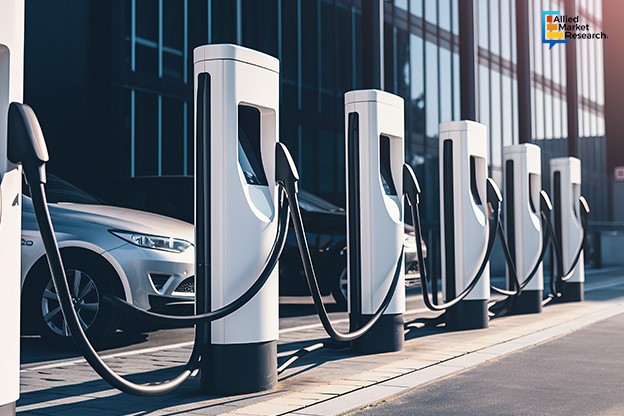Beyond the Plug: A Comprehensive Overview of Innovations in Electric Vehicle Charging Stations

27 Dec
2024
Highlights:
- Introduction
- Fast and wireless charging reducing waiting time
- Mercedes-Benz and Siemen’s collaboration in 2022
- Optimizing efficiency and cost using smart chargers
The transition to electric vehicles has occurred as a measure to reduce carbon emissions, replacing traditional internal combustion engine vehicles. The rising demand for EVs requires charging speed, cost-effectiveness, and energy efficiency. Innovations in charging technology have changed the landscape, significantly reducing charging times, enhancing user accessibility. It has also made EVs more affordable and sustainable. These progressions have deeply influenced the increasing adoption of EVs and helped to reduce the environmental footprint.
Optimizing efficiency and cost using smart chargers
Smart charging systems control the charging process remotely through a smartphone app. Drivers get more flexibility and control over when and how their vehicles are charged. They communicate with the electrical grid. It enables the system to adjust charging times based on grid demand or energy availability. This not only reduces the strain on the grid but also makes charging more affordable by taking advantage of lower electricity rates during off-peak hours.
In addition, smart charging systems integrate vehicle-to-grid technology. V2G allows EVs to return energy to the grid, offering a valuable service to utilities. This two-way flow of energy helps stabilize the grid, specifically during high demand periods. The incorporation of V2G EV charging stations is the factor expected to offer lucrative growth opportunities for the electric vehicle charging station market during the forecast period. In 2023, Lotus launched its own charging solutions, including an ultra-fast 450 kW DC charger. They were designed to enhance charging infrastructure and accelerate the adoption of electrification.
Fast and wireless charging reducing waiting time
In the past few years, charging an EV required several hours, which made long-distance travel and daily use inconvenient. However, the new charging technologies have drastically reduced this wait time. Ultra-fast chargers deliver power at much higher rates than regular ones, allowing vehicles to recharge fast. These high-speed chargers are capable of providing up to 350 kW of power, which translates to an 80% charge in as little as 20 to 30 minutes. Drivers have shorter stopovers and continue their journeys with minimal delay by installing ultra-fast charging stations along highways and major routes. In 2024, Hubject, the leading player in EV interoperability, partnered with Exicom, India’s largest EV charger manufacturer. This collaboration aimed to enhance the EV charging experience in India through Hubject’s innovative interoperability technology, particularly its intercharge platform.
In addition, wireless charging eliminates the need for physical cables, making the process of charging more convenient and efficient. The system uses electromagnetic fields to transfer energy from a charging pad to a vehicle's receiver. This allows the car to charge as it parks over the pad. This system not only removes the need for plugging in cables but also introduces the possibility of dynamic wireless charging. Rapid charging involves the ability to charge vehicles while they are in motion. Specialized roads are equipped with charging pads that continuously charge EVs as they drive. This technology has the potential to significantly reduce the number of charging stops needed, especially for long trips.
Mercedes-Benz and Siemen’s collaboration on developing inductive charging systems
Mercedes-Benz partnered with Siemens to explore wireless charging solutions for EVs in 2022. This collaboration focused on developing inductive charging systems that integrated into parking spaces and roadways, allowing for both static and dynamic charging capabilities. It enhanced the convenience of EV charging by implementing inductive charging technology, which uses electromagnetic fields to transfer energy from a charging pad to a vehicle's receiver. This system not only helped in parking-based charging but also opened possibilities for vehicles to charge while moving.
Endnote
Public charging stations are now commonly found in shopping malls, office buildings, parking garages, and residential complexes. In addition, more charging stations are being installed along highways, at rest areas, and in public parking lots. In response to the growing demand, charging infrastructure providers have standardized the charging process. This includes ensuring that stations are compatible with a wide range of EVs and adopting universal charging connectors. Along with these initiatives, technological innovations like smart and wireless charging create a seamless experience for EV owners. This is expected to boost the use of EVs in future and eventually minimize carbon footprint in the environment.
For more insightful business updates and the latest trends in the electric vehicle charging station industry, contact our in-house experts today!

Koyel Ghosh
Author’s Bio- Koyel Ghosh is a blogger with a strong passion and enjoys writing in miscellaneous domains, as she believes it lets her explore a wide variety of niches. She has an innate interest in creativity and enjoys experimenting with different writing styles. A writer who never stops imagining, she has been serving the corporate industry for the last five years.
Avenue: Entire Library membership of Allied Market Research Reports at your disposal
- Avenue is an innovative subscription-based online report database.
- Avail an online access to the entire library of syndicated reports on more than 2,000 niche industries and company profiles on more than 12,000 firms across 11 domains.
- A cost-effective model tailored for entrepreneurs, investors, and students & researchers at universities.
- Request customizations, suggest new reports, and avail analyst support as per your requirements.
- Get an access to the library of reports at any time from any device and anywhere.
Related Post
-
How are Submarine Cables Transforming Global Connectivity with Enhanced User Experience?
-
Endoscopy Procedures: Transformations in Techniques and Applications
-
AI-Powered Video Analytics: How the Product Actually Works for enterprises
-
Painting Robots: Transforming Precision Coating and Creative Applications
-
Innovations in Pharmacovigilance Systems Advancing Patient Safety
-
Understanding Edge Security: Keeping Data Safe Near the Source
-
Exploring the Use and Advancements of 3D Laser Scanners in Professional Applications
-
Reinforcing Industrial Controls with Smarter Tools and Training








